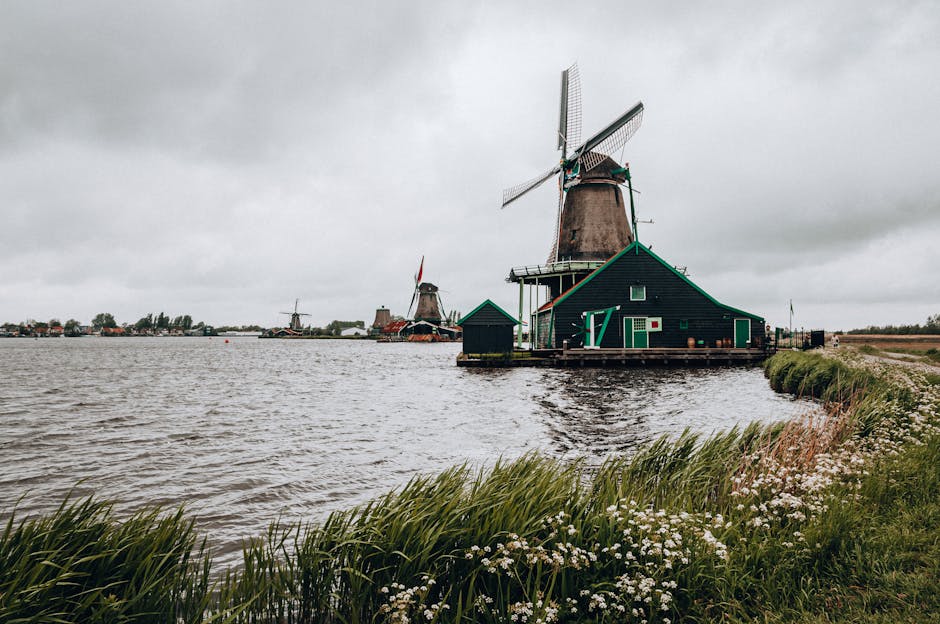
In the face of escalating climate change challenges, the Netherlands, renowned globally for its robust water management systems, is implementing new strategies to mitigate risks and enhance resilience. As a country largely below sea level, the Netherlands has long been a pioneer in water management, and its 2025 strategies are crucial in addressing the complex interplay between rising sea levels, increased rainfall, and sustainable urban development. This deep dive explores how these cutting-edge strategies aim to safeguard the Dutch landscape, livelihoods, and legacy against the threats posed by climate change.
The Evolution of Dutch Water Management
The Netherlands has a rich history of water management, dating back to the Middle Ages when communities first constructed dikes and drained marshlands to create arable land. Over the centuries, the Dutch have perfected their techniques, leading to the creation of sophisticated infrastructures such as the Delta Works and the Zuiderzee Works, which are considered engineering marvels. As climate change accelerates, these historical frameworks provide a solid foundation for the country’s 2025 initiatives, which emphasize sustainability, innovation, and community involvement.
Key Components of the 2025 Water Management Strategies
The 2025 Dutch Water Management Strategies are multifaceted, encapsulating a range of initiatives designed to combat the distinct threats posed by climate change. Key components include:
Innovative Infrastructure Development
- Floating Homes and Offices: Embracing amphibious living solutions, the Netherlands is promoting the development of floating structures that can adapt to changing water levels.
- Smart Dikes: Integration of smart technologies into dike systems allows for real-time monitoring and adaptive response to potential threats, enhancing flood prevention efforts.
- Green Roofs and Walls: Urban areas are encouraged to incorporate green infrastructure, which helps manage rainwater, improves air quality, and reduces urban heat.
Nature-Based Solutions
- Wetland Restoration: Restoring wetlands not only provides natural flood defenses but also supports biodiversity and carbon sequestration.
- Room for the River: Expanding floodplains and reconnecting rivers to their natural courses reduces flood risks while creating new recreational spaces and habitats.
Water Conservation and Recycling
- Efficient Water Use: The government is promoting technologies that reduce water consumption and encourage rainwater harvesting and greywater recycling systems.
- Water Pricing Strategies: Implementing pricing models that reflect true water scarcity aims to incentivize conservation among consumers.
Community Involvement and Education
- Public Awareness Campaigns: Engaging citizens through educational initiatives about water conservation and flood preparedness is key.
- Participatory Governance: Involving local stakeholders in decision-making processes ensures that diverse perspectives are considered in water management planning.
Impact of Climate Change on Dutch Water Management
Climate change exacerbates existing water management challenges, manifesting as extreme weather events, rising sea levels, and shifting precipitation patterns. These changes necessitate adaptive management approaches that not only address immediate risks but also prepare for future uncertainties. The Dutch government recognizes the importance of addressing the root causes of climate change and is committed to integrating climate adaptation with broader sustainability goals.
Rising Sea Levels
With projections indicating significant sea-level rises by the end of the century, the Netherlands is prioritizing coastal defense enhancements. Strategic reinforcements of dikes and levees, combined with innovative coastal barriers, aim to protect low-lying areas from inundation.
Increased Precipitation and Flooding
More frequent and intense rainfall events pose a significant threat to urban and rural areas alike. The 2025 strategies emphasize the need for improved drainage systems and floodplain expansions to manage excess water effectively.
Water Scarcity and Drought
While flooding is a primary concern, periods of drought are becoming more common, impacting agriculture, ecosystems, and water supply. Adaptive measures focus on improving water storage and enhancing the efficiency of water use across sectors.
Technological Innovations in Water Management
Technological advancements are central to the Netherlands’ ability to respond dynamically to climate change threats. The integration of digital technologies and data-driven approaches is transforming traditional water management practices.
Data-Driven Decision-Making
- Real-Time Monitoring: Deploying sensors and satellite technologies enables continuous monitoring of water levels, weather patterns, and infrastructure integrity.
- Predictive Modeling: Advanced models simulate potential climate scenarios, allowing policymakers to plan proactively and develop targeted interventions.
Smart Water Management Systems
- Automated Irrigation: Systems that use weather data to optimize irrigation schedules help reduce water waste in agriculture.
- Intelligent Water Networks: Smart meters and leak detection technologies enhance the efficiency and reliability of water supply networks.
International Collaboration and Knowledge Sharing
The Netherlands’ expertise in water management is not only applied domestically but also shared internationally. Collaborative initiatives with countries facing similar challenges foster knowledge exchange and joint solutions to global water issues.
Partnerships and Projects
- European Union Cooperation: The Netherlands is actively involved in EU-funded water management projects, contributing to a collective European response to climate change.
- Global Knowledge Networks: Participation in organizations like the Global Water Partnership enhances the Netherlands’ role in setting international agendas on water resilience.
Exporting Dutch Expertise
- Consultancy Services: Dutch firms offer consultancy services worldwide, providing insights and solutions based on extensive experience in water management.
- Technological Solutions: Exporting innovative water management technologies positions the Netherlands as a leader in global climate adaptation efforts.
Challenges and Opportunities
While the 2025 water management strategies present numerous opportunities for enhancing resilience, they also face challenges in implementation. Balancing environmental, economic, and social considerations requires careful planning and ongoing evaluation.
Resource Allocation
Securing adequate funding and resources is critical to advancing ambitious infrastructure projects and community initiatives. Strategic investments can unlock economic benefits and spur innovation.
Stakeholder Engagement
Effective engagement with stakeholders, from local communities to industry leaders, ensures that diverse interests are represented and that solutions are equitable and inclusive.
Regulatory and Policy Frameworks
Adapting regulatory frameworks to accommodate new technologies and approaches is essential for overcoming bureaucratic hurdles and expediting project implementation.
Sustainability and Environmental Concerns
Ensuring that water management practices align with broader environmental goals, such as biodiversity conservation and emissions reduction, is vital for long-term success.
Conclusion
As the Netherlands pioneers new strategies to address the multifaceted challenges of climate change, its 2025 water management initiatives serve as a beacon of innovation and resilience. By integrating advanced technologies, nature-based solutions, and community engagement, the Dutch model offers valuable insights for countries worldwide grappling with similar challenges. The commitment to adaptive, sustainable, and inclusive water management not only safeguards the Netherlands’ future but also contributes to a global movement towards climate resilience.
FAQ
What are smart dikes?
Smart dikes are traditional dike systems enhanced with modern technologies such as sensors and data analytics. These upgrades enable real-time monitoring of water levels and structural integrity, allowing for timely interventions and improved flood prevention.
How does the Room for the River program work?
The Room for the River program involves expanding floodplains, relocating dikes, and deepening riverbeds to create more space for rivers during high water levels. This approach reduces flood risks and enhances riverine ecosystems.
Why is the Netherlands focusing on floating homes?
Floating homes are part of the Netherlands’ efforts to adapt to rising water levels. These structures can rise and fall with changing water levels, providing flexible living solutions in flood-prone areas while minimizing land use impact.
What role does community involvement play in water management?
Community involvement is crucial as it ensures that water management strategies reflect local needs and knowledge. Engaged communities are better prepared for climate-related events and contribute to more effective and sustainable solutions.
How does the Netherlands contribute to global water management efforts?
The Netherlands shares its expertise through international collaborations, offering consultancy services, and exporting innovative technologies. Its participation in global networks fosters knowledge exchange and supports the development of resilient water management practices worldwide.


